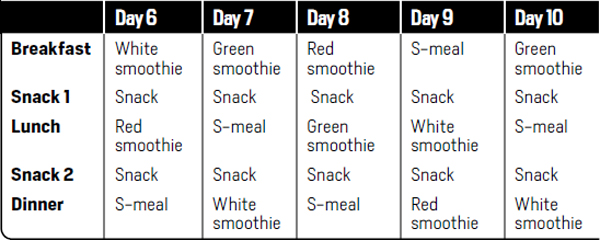

Making the Transition
Phase II: What You’ll Be Doing
You will be eating five times a day: two smoothies, two snacks, and one single-dish meal. You will be walking a minimum of 10,000 steps and beginning a simple circuit of resistance training 3 days a week (or on Days 6, 8, and 10 of the plan).
• A blender
• A pedometer
• A shopping list
You’ve done it! You’ve made it through the first, and surely the hardest, 5 days of the plan. I’d wager that you’re looking and feeling pretty good right about now. How many pounds have you lost? Three? Five? Even more?
In any event, the dramatic results you’ve experienced in the last 5 days have surely been great motivation to continue on with the Body Reset. I promise you it only gets easier at every phase as you gradually ease your way back into the “real world.”
The big dietary change in Phase II is that you’ll now be replacing one of your three daily smoothies with a satisfying single-dish meal. I don’t mind which meal you replace—it really depends on your schedule and your eating habits.
Ask yourself when you’re most vulnerable to pigging out and try to keep that meal as a smoothie. For me, dinner is the toughest time to keep my discipline intact, so that’s the best time for me to have a smoothie. But efficiency is also a factor—when are you most crunched for time? If your morning routine is frenzied, then maybe it makes the most sense to have a smoothie then, when you don’t have time to prepare even the simplest meal. If it’s quicker for you to bring your red smoothie to lunch in a thermos, then by all means do that, and have your S-meal at home with your family at night. If you like the ritual of slowing down and eating a meal with a plate and fork in the little park outside your office building, then bring one of the S-meals with you.
You can work out the details according to your own preferences and time constraints. There just has to be a method to the madness, so figure out what your method is.
Restoring a Passion for Eating
Sooner or later (preferably sooner), after a jump start like Phase I of this plan, we have to make the transition back to single-dish meals. Solid meals take longer to consume than even the most fiber-packed smoothies, and our bodies generally absorb them more slowly, both of which are good for weight loss. And there’s a social aspect to eating that most diets overlook—and because they overlook it, those diets tend not to be sustainable. We are social creatures, and we can go only so long drinking every meal on our own. The smoothie is absolutely critical for the success of the kick start: It is the most efficient, nutrient-packed way to shed pounds fast without devoting your entire day to obsessing about weight loss.
So while there is only so much variety you can get from a blender, and variety—of texture, flavor, and color—it’s also important to include other aspects of eating. Solid foods can give you a satisfying variety that smoothies cannot. Solid foods also take longer to digest, and sitting down to eat them is your chance to breathe and recharge. When you eat solid foods, your mouth acts as the blender, and you need to take time to ensure that it does its work properly.
Digestion, after all, starts in your mouth, both in its mechanical aspects, which set off a whole cascade of digestive processes in your stomach, and in the enzymes released by your saliva. So when you slow down to chew every bite carefully, you’ll increase the amount of nutrients absorbed into your body.
So let’s start to make the transition back to solid foods. Of course, whenever you get too busy or hectic or feel the need to reset your habits again (or shed more weight in a hurry), you can always turn back to the three-smoothies-a-day tool, but I don’t really think it’s realistic to live primarily off smoothies for the rest of your life. One to two smoothies a day, however, is sustainable, so that’s what you’ll transition to in Phase III and beyond.
Restoring a passion for eating is central to the long-term success of this plan. Yes, we all lead fast-paced lives and seldom come up for air. But when we pay too little attention to what we’re putting into our mouths, we keep on eating and eating regardless of whether we’re still hungry or even whether we like the food! I want you to reclaim not only a healthy lifestyle, but the enjoyment of the ritual of eating—gathering around the table with friends and loved ones, savoring every morsel of both food and conversation.
What You’ll Be Learning: Basic Food Prep
The first thing I want to emphasize is that my recipes are EASY, so don’t feel overwhelmed. The time commitment involved in making these meals will be 5 minutes or less, I promise. You can (and will!) prepare simple, delicious, and nourishing meals in a snap.
Taking control of your body (and what goes in it) does call for a measure of self-reliance in the kitchen, but that doesn’t mean that cooking has to be a headache—on the contrary. These recipes will show you exactly how easy it can be to make great food.
To show you just how simple cooking can be, we’ll be starting with super-easy one-dish meals like stir-fries and soups that adhere to the basic principles of the Body Reset, meaning they all contain a great balance of proteins, fiber, and healthy fats, and they all take under 5 minutes to prepare. Their nutritional profile—calorie count and fiber and protein content—is roughly equivalent to that of the smoothies; the main difference is that we consume them with a knife and fork instead of a straw.
Mastering Basic
Meal Preparation
Learning to prepare your own meals can fundamentally change the way you eat, and the Body Reset meals are the perfect springboard for cooks of all experience levels, from gourmet chefs to total kitchen-phobes. Studies show that people who prepare meals at home feel more emotionally rewarded after eating them. When you’re preparing your own food, you also know exactly what’s in every meal, which is not usually true of meals you order at restaurants or pick up in convenient little boxes in the freezer section of the supermarket. It should come as no surprise that food prepared at home tends to have a much lower calorie count than food ordered in a restaurant. An average restaurant meal contains between 1,000 and 2,000 calories, or between 50 percent and 100 percent of the total calories you should consume daily. By following The Body Reset Diet, you won’t be frequenting restaurants as often as the average American, who eats out at least five meals weekly. Self-reliance in the kitchen and a tendency to eat more at home will yield big savings—in both the wallet and the waistline—over the years.
The key to these meals is SIMPLICITY, which is why I call them S-meals. S stands for both Simple and Single dish, and also for the actual type of dishes:
• Salads
• Sandwiches
• Soups
• Stir-fries
• Scrambles
Simple = No Excuses. These meals are simple in terms of time, accessibility of ingredients, and preparation method—and simply delicious!
On page 183, I’ll give you many options for each of these recipes. You can have Sweet Potato Hash with Chives (page 189) on Day 6, and try out the Southwestern Tuna Tortilla Wrap (page 198) on Day 7. There’s something for everyone, and I promise that no matter how inexperienced you are in the kitchen, you will be able to make these meals in no time at all—and feel that much more satisfied with the food (and yourself) for having done it on your own.
Later, as you move into the rest of your life phase, I encourage you to pick up some of my previous books to experiment with more delicious simple recipes. Those recipes are also incredibly filling, and a cinch to prepare no matter what your time constraints. But for now, let’s stick to the one-dish meals, like the amazing Tuscan White Bean and Kale Bruschetta (page 220) and the mouthwatering Dijon Lentil Salad with Baby Spinach (page 212), which are truly as Simple as it gets!
Planning Ahead
Just as in Phase I, to succeed in Phase II you need to do some advance planning. Before you go to bed, think about what you’ll eat the next day. Although this plan allows you to be flexible about what you eat, I do want you to continue alternating the smoothies in pretty much the same order, even as you go down to two a day. Over the years, I’ve found that establishing a routine helps you succeed in planning ahead to prepare meals. Obviously, the choices you make will really depend on your mood, and when you’ll be in your kitchen and when you’ll be on the move, and what you ate the day before and what you happen to have in your pantry.
The following chart is by no means a hard-and-fast template. It’s merely an attempt to show you how you can alternate your meals and smoothies for maximum flexibility. If you strongly prefer the white to the red smoothie, then you can have the white smoothie more often, but please don’t exclude one type entirely. These smoothies were designed to give you the proper balance of nutrients when eaten in alternation. Try to rotate them.
The same goes for the S-meals. If it’s the sweltering middle of summer, I totally understand that you won’t be eating as many hot soups, but that doesn’t mean you have to eat the exact same sandwich every single day. The success of a diet depends on variety, so try to eat as many different dishes as you can, especially early on when you’re still figuring out what works for you.
PHASE II

Some Preliminary Tips for Transitioning Back to Solid Meals
• Try to eat your solid meals while sitting down (and no, driving doesn’t count). Put down your phone, turn off the TV, and try to focus on what you’re eating for the few minutes that you have. Enjoy your meals and you won’t find yourself mindlessly snacking quite so often.
• Plot out your mealtimes well in advance. Don’t get yourself in a situation where you’re so ravenously hungry that you eat everything in sight.
• Chew your food slowly and deliberately.
• When you have eaten three-quarters of the food on your plate, wait several minutes and see if you’re still hungry or if you can save that portion for leftovers.